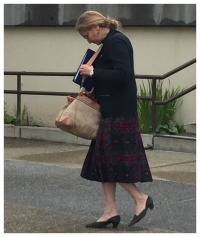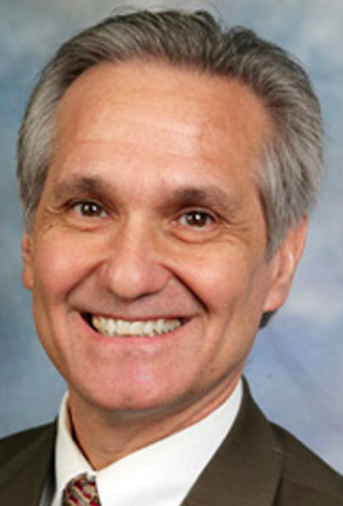Alice Rogoff, the owner of the Alaska Dispatch News (and associated companies), made her first in-person appearance in bankruptcy court today, where she answered questions under oath. During previous hearings, she had appeared telephonically.
Dressed in a dark merino wool cardigan, a Pendleton-style, box-pleat skirt, sensible heels, and carrying a well-worn boho bag, Rogoff sat before the U.S. Bankruptcy Court trustee Kathryn Perkins, and revealed as little as possible in her answers.
Some of her responses appeared to be well-coached by her bankruptcy attorney, Cabot Christianson, to whom she has paid $50,000 to handle her affairs as she tries to extract herself from having to pay the tens of millions of dollars in debts she owes.
The questions Rogoff faced today came from a handful of the more than 100 companies to which she owes a great deal of money.
It was a cat-and-mouse game, with creditors asking questions that mystified the audience of reporters, creditors, and curiosity seekers.
But Rogoff’s lawyer knew exactly what the questioners were trying to get at — and he deflected some of the questions by objecting to them, and at other times he jumped in with an answer to keep Rogoff from speaking to a topic herself:
“It’s all in here in excruciating detail,” Christianson said twice, referring to his most recent document filing that explained how the companies Rogoff set up were entwined.
When asked by the court trustee when she knew her business was financially on the rocks, Rogoff unequivocally said she wasn’t in trouble until GCI filed an eviction notice on Aug. 11. She made sure to mention that point twice, so the bankruptcy trustee would be sure to note that the collapse of the business is GCI’s fault.
But a review of the history shows that she stopped paying her bills back in 2015. She ran up unpaid utility bills with GCI at the rate of $1,500 a day and, combined with overdue rent, she was $1.4 million in arrears to the landlord at the place where her press operates on Northway Drive.
“At this time (Nov. 30, 2015) ADN also indicated to GCI that it could not and would not pay a series of unrelated invoices totaling $205,558.00 for work GCI completed on ADN’s new office premises on 31st Avenue (the “31st Avenue Receivable”), again because of a shortage in cash flow,” the eviction complaint said.
“To assist ADN in remaining operational, on January 21, 2016, GCI agreed to a Settlement Agreement pursuant to which GCI CC accepted advertising credits in lieu of cash payment of the 31st Avenue Receivable.”
January, 2016 is also when Rogoff stopped paying her former business partner, Tony Hopfinger, who says she owes him $900,000. He filed a lawsuit a few months later when she decided she didn’t owe him anything further than the $100,000 she had already paid.
Meanwhile, at the GCI building housing the press, her situation continued to deteriorate, according to GCI’s request to the court to assist in evicting the newspaper.
“In an attempt to again support continued operation of ADN, GCI tried to negotiate a second settlement agreement in February of 2016 to provide for repayment of the outstanding Holdover Rent via in-kind advertising credits and permit ADN to remain in the Premises pursuant to this arrangement through April 30, 2017.
“ADN did not agree to GCI’s proposed terms for the second settlement agreement and negotiations ceased at the end of February , 2017.”
“Since February of 2017, GCI has presented alternatives to Rogoff to enable ADN to continue operations and to prevent forcible evictions. None of these alternatives were acceptable to Rogoff.”
Rogoff, according to GCI’s eviction request, had simply stopped negotiating with GCI. She wouldn’t take GCI’s calls. This is the same Rogoff who claimed to the court that she wasn’t in financial trouble until August 2017, when GCI issued the eviction notice.
SHE HAS THE MONEY
Thursday’s proceedings revealed that Rogoff has $1.7 million in personal funds in a Wells Fargo account, and yet chose to borrow up to $1 million from the Binkley Company to keep the newspaper running for a month — including emergency payments to workers, health insurance, and other insurance premiums that were past due.
Although she revealed her investment account balance to the court, Rogoff was unwilling to reveal to the court the details of her marital allowance. She said it was personal and none of the creditors’ business.
But, just as she tried to hide her personal information in an earlier lawsuit filed by her former partner Tony Hopfinger, that marital allowance, believed to be $5 million per year from her estranged husband David Rubenstein, will eventually be made known in a “2004 deposition” (a bankruptcy tool that allows a bankruptcy trustee, a creditor, or debtor to probe for documents relevant to the issues in the case).
Rogoff also is claiming to be a victim of her company and considers herself a creditor. Last month, she said the company owed her $8 million, but this week that amount was increased to more than $12 million which makes her supposedly the largest unsecured creditor of the more than 100 others who are waiting in line to be paid.
ARE THE BINKLEYS BEING USED?
Rogoff told the court that before her bankruptcy filing, she had explored many options for the newspaper, including selling it, developing a joint operating agreement with another company, or creating a nonprofit to operate the paper in the same manner that the Fairbanks Daily NewsMiner operates under the Snedden Foundation.
Rogoff had earlier been negotiating with the Binkley Company but had walked away from those negotiations earlier in the summer. It wasn’t until she hit a crisis point with the impending eviction when her attorney called the Binkleys and asked them to save the newspaper, or else the paper that was published the following day would be the final one.
The Binkleys came to the rescue, and got permission from the court and her major creditors to be allowed to loan the newspaper up to $1 million to keep it afloat prior to the bankruptcy auction sale, which occurs Monday in Anchorage. The Binkley Company hopes to be the high bidder.
Meanwhile, Rogoff appears to have been working behind the scenes with other buyers, who will try to outbid the Binkleys for the newspaper, even though they have a purchase agreement with her.
In court, Rogoff did not seem warm to the Binkley Company principle, Ryan Binkley, who sat in the gallery observing the proceedings. She neither greeted nor acknowledged the family that came from Fairbanks and spent their summer trying to save the paper.
Besides the Binkley Company, Steve Malkowich of Alberta Newspaper Group has been spotted in Anchorage doing due diligence on the newspaper assets, and appears to be a credible bidder, according to those close to the newspaper operations.
THE CORPORATE VEIL
Wednesday’s questions from creditors looked to be strategic in attempting to pierce the “corporate veil,” and show that Rogoff was operating the business from her personal accounts, and therefore has personal liability.
Creditors want to get at the $1.7 million in her investment accounts to recover a portion of their losses.
Mark Miller, of M&M Wiring, was particularly interested in the relationship between her attorney, Adam Cook, and the unfinished construction project to install two presses at the 59th and Arctic Blvd building. His company had performed a lot of the wiring at the Arctic Blvd. building, half of which is unpaid.
“Did you authorize Adam Cook to communicate with the contractors and subcontractors during the Arctic project?” asked Miller, who believes he is owed about $500,000 by Rogoff for work his company performed.
Yes, she answered.
“Did you authorize Adam Cook to tell the contractors on the project that they would be paid?” Miller continued.
No, she responded. But Miller was referring to an email from Cook to the contractors, telling them to continue the work and that ADN would pay them. That was his smoking gun.
“At any point in time during the project did Adam Cook step in as project manager in place of Ed McCoy?” Miller asked.
Rogoff hesitated. “Well, not technically,” she said. Cook was her lawyer.
And that may have been exactly the answer that Miller was looking for in showing the court that her attorney from Birch, Horton, Bittner, Cherot was aware of her financial situation and did not act in a responsible manner on her behalf, mixing the job of being her attorney with the role of being her defacto project manager.
Exchanges such as this one were likely mysterious to most court observers, but had real goals for the creditors, who were having their first shot at challenging the woman who is getting ready to stiff them for millions.





